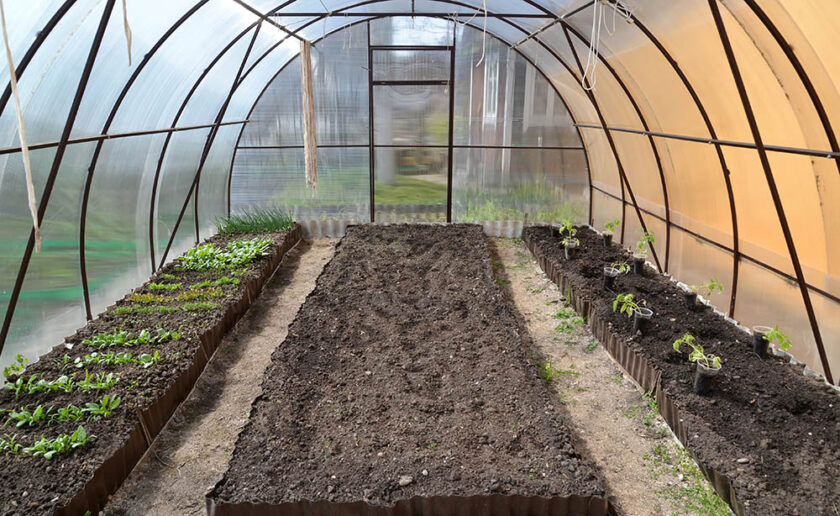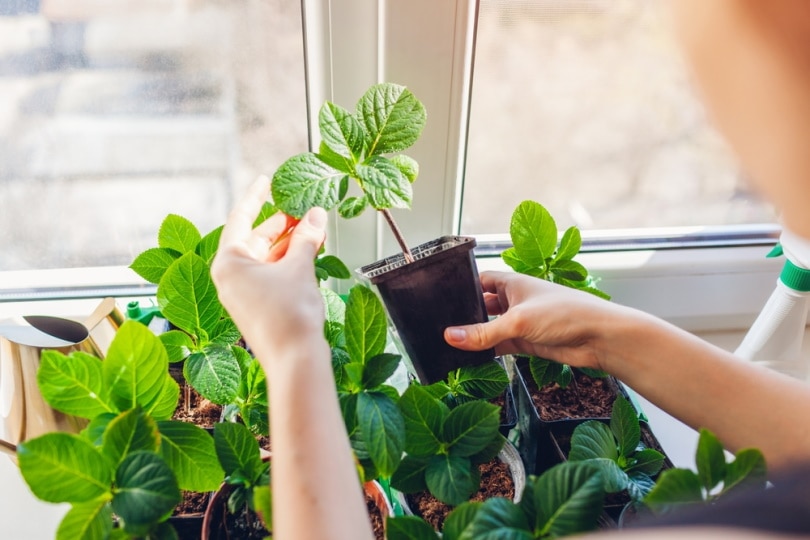The Ideal Greenhouse Temperature & Humidity (2025 Guide)
-
Lindsey Lawson
- Last updated:

A greenhouse’s purpose is to provide a safe place for your plants to grow and thrive regardless of climate, current weather conditions, or the season. The only way you will have a successful greenhouse is by keeping it in the proper conditions that your plants need.
One of the biggest mistakes that a gardener could make is failing to control the temperature and humidity within their greenhouse. So, what is the ideal temperature and humidity for these highly convenient plant nurseries? Read along to learn more.
Normal Greenhouse Temperature/Humidity
Greenhouse Temperature
The temperature in your greenhouse is of the utmost importance. Temperature controls the plant’s rate of development and the timing of the crop yield. Not only does it directly affect the growth of plants, but it also affects the quality of your crops and the energy consumption within the greenhouse.
The ideal temperature of the greenhouse can vary slightly depending on the season and the plants within the greenhouse. It is generally kept at an ideal range between 75- and 85-degrees Fahrenheit with lower nighttime temperatures between 60- and 75-degrees Fahrenheit.

Greenhouse Humidity
In addition to temperature, you will also want to maintain the correct humidity. Most plants require humidity ranging anywhere from 50 to 80 percent. The recommended humidity level for optimal plant growth in a greenhouse is 80 percent.
Too much humidity can significantly reduce your yield because humidity directly affects the transpiration rate and the absorption of nutrients.
A lack of humidity can cause excessive drying, and the plant will then begin to try and minimize water loss, which slows photosynthesis. This often results in stunted growth and a slower yield.
Normal Greenhouse Temperature/Humidity in Winter
It is generally recommended that greenhouses be kept between 65- and 75-degrees Fahrenheit during the wintertime. It should never be allowed to drop below 55 degrees for the safety of your plants. While some plants can be cold hardy, some do not fare well in colder temperatures.
You should have a good idea of what the plants within your greenhouse need, as you may need to adjust these temperatures accordingly. Your region will also play a role in temperature fluctuations. Those in colder, northern climates will have to work harder to keep their greenhouses at optimal temperatures during the coldest part of winter. Make sure to maintain that humidity level between 50 and 80 percent as well, since winter tends to be the driest season due to heating requirements.

Normal Greenhouse Temperature/Humidity in Spring
During the spring you can keep the greenhouse temperature very similar to typical springtime weather when plants begin to thrive and bloom. For the most part, a temperature between 70 and 80 degrees is ideal for springtime but this will depend on the plants in your care.
Normal Greenhouse Temperature/Humidity in Summer
During the heat of summer, there is no reason to let your greenhouse get any hotter than 85 degrees. Most opt to maintain temperatures between 75- and 85-degrees Fahrenheit. It’s a good idea to keep a close eye on the heat during the summer to prevent it from exceeding 90 degrees because you could then be subjecting certain species to heat damage.
Normal Greenhouse Temperature/Humidity in Fall
During the fall, greenhouse temperatures can be kept similar to that of spring, between 70- and 80 degrees Fahrenheit. This is the time of year when temperatures begin to drop but you want to maintain an ideal growing environment for your plants.

What Are the Benefits of Having a Greenhouse?
- Extended Growing Season: One of the biggest advantages of having a greenhouse is that you can significantly extend your growing season and yield many more crops. Since you are in control of the temperature and humidity within the greenhouse, you can allow for optimal growing conditions regardless of your climate.
- Weather Resistant: With a greenhouse, you do not have to worry about weather conditions causing harm to your plants. Gardening in less-than-savory weather conditions can harm your yield. If you are experiencing a particularly rainy season or your area has been stricken with drought, that won’t matter.
- Ideal for a Variety of Plants: Greenhouses allow you to grow a wide variety of plants in one spot. You are not limited to available space in your home or your yard. You will be able to attempt to grow any plant of your choosing because you have a controlled environment that allows you to maintain optimal conditions for your plants.
- Protection from Pests and Animals: One of the most frustrating things as a gardener is trying to keep garden pests and animals from destroying your plants. Greenhouse plants will still be susceptible to certain pests but if you are keeping on top of prevention, the occurrence can be much less. They also keep animals like rabbits, deer, and birds from picking off your crops before you get a chance to enjoy them.
- Optimal Growing Environment: Regardless of what plants you choose to grow in your greenhouse, you can create the optimum growing environment for a variety of herbs, flowers, vegetables, fruits, and ornamentals. A greenhouse gives you a much higher chance of success with any plant of your choosing.
How to Ensure a Successful Greenhouse
1. Proper Ventilation
Regardless of the size, a greenhouse must have proper ventilation. You can either use natural ventilation or mechanical ventilation using fans. Fans will not be a requirement if there is adequate ventilation through the roof and sidewall vents that allow hot air to escape and fresh cool air to enter.

2. Proper Heating and Cooling
The proper cooling for greenhouses is based on ventilation, so you will need to consider the type of greenhouse you are working with and the best ventilation method. Most greenhouses can easily be heated using standard gas heaters, but you can look into different greenhouse heating systems that fit your size and space requirements.

3. Keep Your Greenhouse Clean and Organized
Cleaning is a chore whether it be in the home, yard, or out in the greenhouse. Keeping your greenhouse clean and tidy is one way to keep it running successfully. If you allow it to become cluttered and disorganized, it can be much more difficult to maintain in the long run.
Organize your plants per your preference and always put away anything that you have dragged out and used for maintenance. Don’t allow it to become a storage space for unused equipment or other material.

4. Have the Correct Amount of Space
The amount of space you need in your greenhouse is going to be based on your preferences, budget, and space available in your yard. You don’t want to overboard and load your greenhouse with more plants than it can handle. Know what kind of space each plant needs and organize accordingly. This will ensure they can grow successfully without any limitations.

5. Keep the Pests Away
Pests are an unfortunate aspect of gardening. Thankfully, greenhouses are a great way to reduce infestations, but you still need to be proactive with preventative measures. Inspect each plant carefully before bringing them into the greenhouse. Look them over to see if you can find any adult insects, eggs, or any other signs of a potential infestation. Treat any plants with an appropriate pesticide before moving them into the greenhouse. This will prevent any potential infestation from spreading to other plants.

 Greenhouses vs Grow Tents
Greenhouses vs Grow Tents
Not everyone has the space or ability to put up a greenhouse, which is where grow tents come in. Grow tents are very popular among green thumbs that like to grow indoors either out of preference or limitations.
Grow tents take up minimal space and allow for a year-round garden right in the home. They allow gardeners to start germination indoors to wait for outdoor planting or they can see the plant from seedling to full maturity.
The three main differences between a grow tent and a greenhouse are location, material, and size. Obviously grow tents are small and can fit inside most rooms inside of a house and are only suited for the indoors. They do not use sunlight to promote growth but rely on artificial lighting and exhaust fans to promote proper conditions.
 Frequently Asked Questions (FAQs)
Frequently Asked Questions (FAQs)
Can I have a greenhouse in a cold climate?
Yes, greenhouses are ideal for those that live in colder climates because they allow the gardener to have more control of their plants. It’s a good idea to shop around for cold weather hardy greenhouses if you do not plan on building one yourself, this will make maintenance much easier during those cold months. You will need to ensure it is properly heated throughout the winter to prevent any problems.

How do greenhouses retain heat?
Greenhouses retain heat through the sunlight. They are designed to trap the heat from the sun so once the heat gets into the greenhouse it cannot get out.
Do greenhouses require a lot of maintenance?
Yes, like gardens, greenhouses will require a fair share of maintenance. It’s not so much the greenhouse itself, but the plants inside it that will have certain care requirements that need to be met. You can choose what you grow, so you have full control over how easy or how hard it is to maintain. With the greenhouse, you just need to make sure it is in tip-top shape and your temperature and humidity requirements are met.
Are greenhouses expensive?
Greenhouses vary in upfront cost because they come in all different shapes, sizes, and materials. If you are interested in a greenhouse, you can surely find one that suits your budget and if it’s something you enjoy, you can always upgrade later.
What if I don’t have room for a greenhouse?
If you don’t have enough room for a greenhouse, try purchasing a grow tent. You won’t be able to hold nearly as many plants in the grow tent, but you can surely pick and choose your top priorities and have your own little indoor garden all year round.

A Quick Reference Guide
Greenhouse Temperature and Humidity by Season
| Season | Temperature | Humidity |
| Spring | 70-80% | 50-80% |
| Summer | 75-85% | 50-80% |
| Fall | 70–80% | 50-80% |
| Winter | 65–75% | 50-80% |
Conclusion
The temperature in a greenhouse should be kept between 65- and 85-degrees Fahrenheit during the day, depending on the season. Nighttime temperatures will naturally be cooler, but you should never allow a greenhouse to fall below 55 degrees. Humidity should be kept between 50 and 80 percent but always keep your plant species in mind, as some have specific care requirements you may need to work with. There are many benefits to having your own greenhouse and for those that don’t have the room, grow tents are also an option.
See also:
Featured Image Credit: Irina Borsuchenko, Shutterstock
Contents
